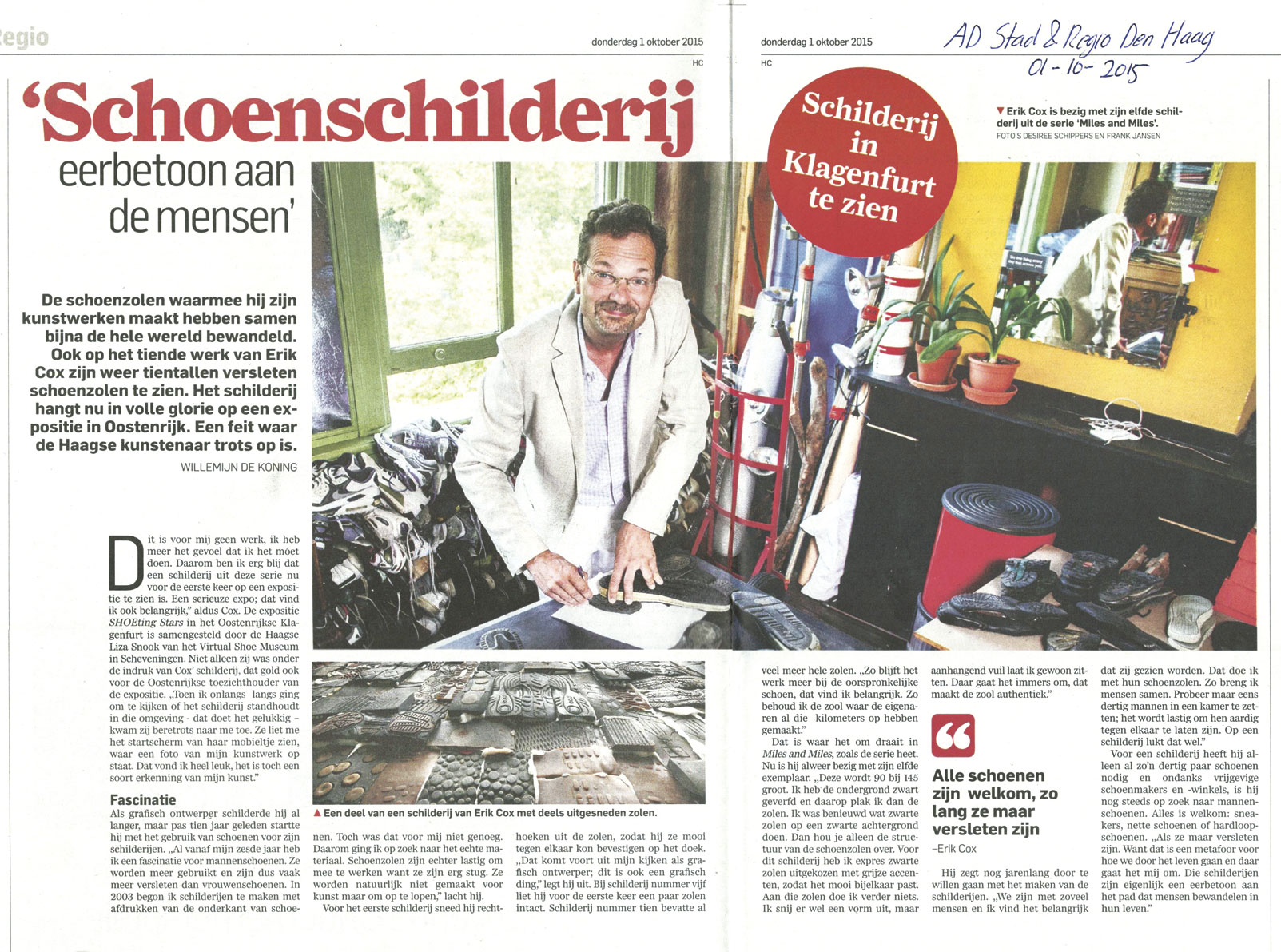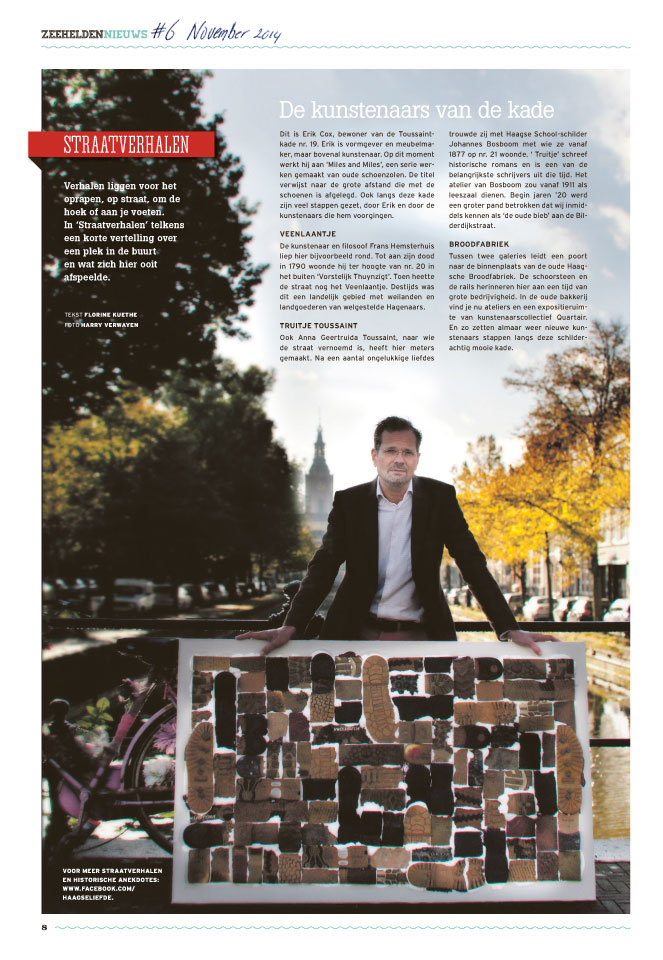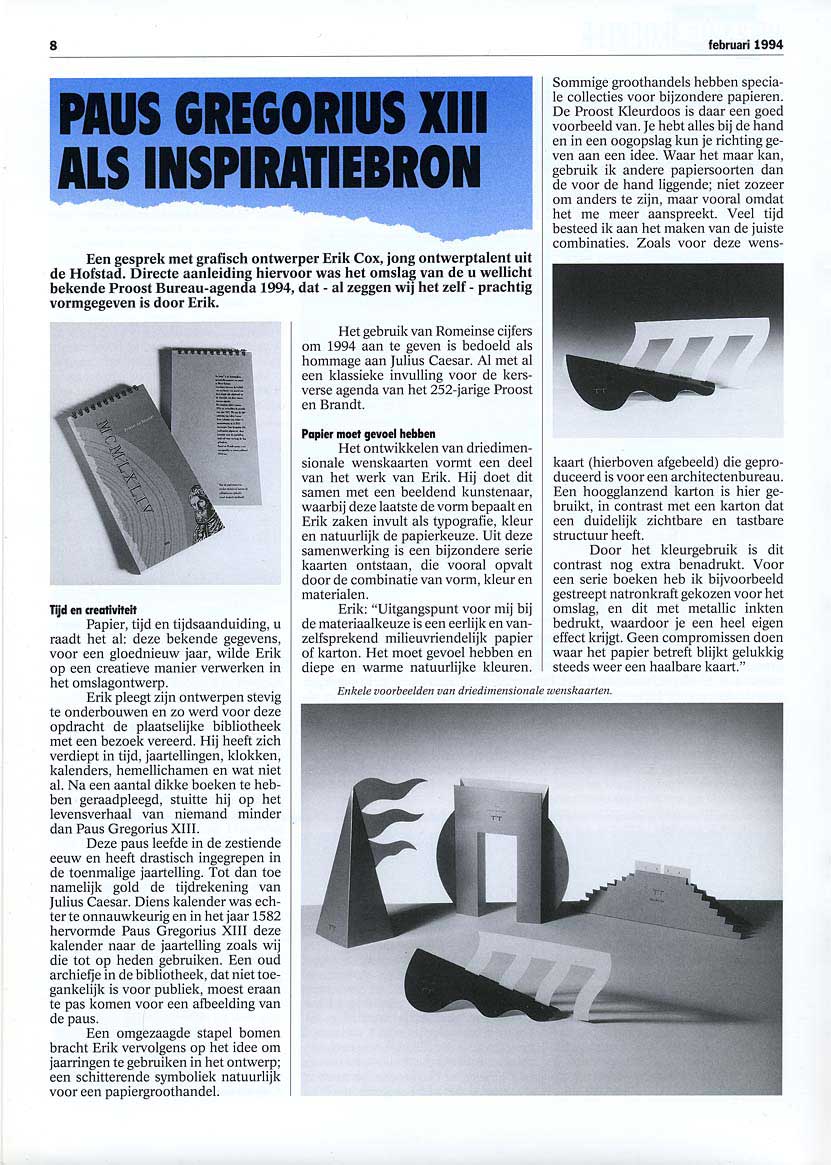–
LEVEN! Blad van ontdekkingen, Jrg 05 Nr 19, Zomer 2013; Tekst: Anouk van der Meer >>
“IK WIL ANDEREN LATEN STRALEN”
Erik Cox is de bedenker van het opvallende, strakke logo van Hotel New York in Rotterdam. Ook ontwierp hij afgelopen jaar een prestigieuze trofee voor Shell. Hij is grafisch ontwerper en kunstenaar.
Het huis en tevens werkplek van Erik Cox aan de Haagse Toussaintkade is een beleving. Alle ruimtes zijn gevuld met zelfgemaakte kunst, antiek en persoonlijke accessoires. We hebben te maken met een man met een eigen smaak.
“Heel opvallend. De sfeer in mijn huis doet denken aan dat van mijn oma. Het creatieve heb ik van haar. Zij kon emoties omzetten in verrassende composities. Als mijn oma nu zou zien welke stap ik heb gezet, zou ze me stimuleren om door te gaan. Ze zou zeggen: ‘Jíj doet wat ik nooit gedurfd heb.’”
Schoenen
En dat is ontwerpen, kunst maken, naar buiten treden. “Ik wil anderen laten stralen. Een aantal jaar geleden ben ik in het centrum van Den Haag briefjes bij mensen in de bus gaan stoppen met de tekst ‘kunstenaar zoekt voor project oude schoenen’. Ik kreeg weinig reactie, maar ik wist dat ik iets met schoenen moest doen. Wàt wist ik nog niet precies.”
Erik werkt nu aan een serie schilderijen bestaande uit, letterlijk, oude schoenzolen. Al die kilometers die de schoenen samen hebben afgelegd, hoe ze zijn afgesleten, de voetafdrukken, het contact met de aarde, fascineren hem. Erik verbindt in deze schilderijen, met de titel Miles and Miles, mensen met elkaar.
Veelzijdig
Dat doet hij ook in zijn andere werk. Dat kan, zoals onlangs, het ontwerpen van een trofee voor Shell zijn, waarin hij alles met elkaar verbindt voor een wereldwijd Credit Management Project. Of het ontwerpen van logo’s, affiches of boekomslagen zoals voor de Enquêtecommissie Van Traa. Ook het logo van de lunchroom aan de ingang van de Paleistuin in Den Haag: Van Prinse & Co komt van zijn hand. Erik vindt zijn voldoening en geluk als hij anderen kan laten stralen, zodat zij een blijvende indruk achterlaten.
(194 KB PDF)
–
–
Translation of an article in LEVEN! / LIFE! Magazine for explorers, Number 19, Summer 2013; Text: Anouk van der Meer >>
“I WANT TO INSPIRE PEOPLE TO OUTPERFORM THEMSELVES”
Erik Cox designed the gracefully clean-lined logo for Hotel New York (Rotterdam). He also designed a prestigious trophy for a Shell employee awards program. He is graphic designer, artist and craftsman.
It’s an intriguing experience to enter the home in which Erik Cox has his studio. The various rooms are all decorated with his art, selected antiques, and personal accessories. It’s clear the man has a taste all his own. “It’s striking. The atmosphere in my house is reminiscent of my grandmother. That’s where I got my creative side. She was good at transforming emotions into surprising compositions. If my Gran could see the road I’m on now, she’d encourage me to continue on the same path. She’d say, ‘You’re doing what I never dared to even try’.”
Shoes
And that is: become a designer and artist who presents his works to the world. “I want to spark confidence in people that they can outperform themselves. A few years ago, I put notes in people’s mailboxes in my neighbourhood, with the text ‘please donate old shoes for an artist’s project’. I didn’t get many reactions, but I knew that I wanted to do something with cast off shoes. I didn’t know then exactly what the project would be.” Erik is now working on a series of paintings made – literally – of worn shoe soles. What fascinates him is their contact with the Earth, the many kilometres the shoes travelled together, each pair showing its particular pattern of wear, its unique footprint. In this series, called ‘Miles and Miles’, Erik lets the shoe soles weave the tapestry of all these walkers’ stories.
Versatile
Gathering divergent threads together into a coherent whole, that’s what he does. That can be things like the trophy he recently designed for Shell’s World-Wide Credit Management Programme, in which he unites and depicts various aspects of the programme. Or it can be the design of a logo, a poster, or a book cover such as the one for the Committee Van Traa. The lunchroom at the entrance of the Palace Garden, Van Prinse & Co, also sports a logo designed by Erik. Erik feels happiest and most satisfied when he can light up the best in people, so that they make a lasting impression.
–




